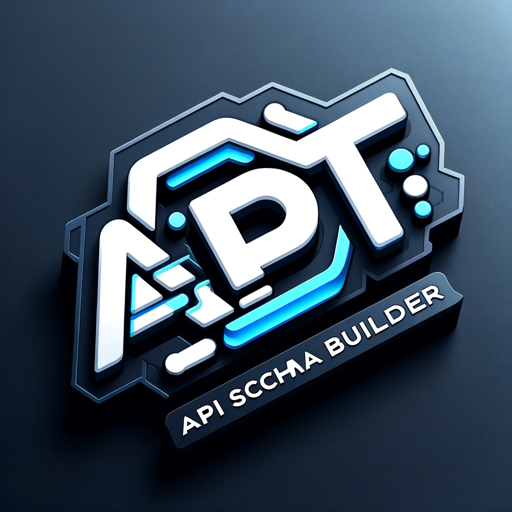API GPT-AI-driven API development tool
AI-powered API creation and design
Example of a tested C++ API
Basic C API with object-oriented design
C++ API validation code example
Design patterns in C API with code
Related Tools
Load More
GPT Builder 助手
转换 API 代码为 GPT Schema

API Alchemist
Advanced tool for creating GPT APIs, specialized in code and OpenAPI Schemas.

Hacking APIs GPT
API Security Assistant

GPT API Schema Builder
Create an API Spec For You Custom GPT. Instantly turn API docs into OpenAPI specs with our tool! Paste a cURL or a doc link, and get a perfect spec in a snap. It’s quick, easy, and error-free. Perfect for devs who want to save time and hassle.

GPT Store
I suggest GPTs based on your needs.

GPT API Key Easy Guide
Simplified Guide to GPT API Keys: Your Assistant for All OpenAI API Key Questions.
20.0 / 5 (200 votes)
Comprehensive Overview of API GPT
API GPT is an AI-powered assistant designed to help users develop, design, and implement Application Programming Interfaces (APIs) across various programming languages. The primary goal of API GPT is to offer users tailored assistance in creating robust, scalable, and secure APIs from conceptualization to final deployment. It caters to both beginners and experienced developers, providing guidance on best practices, object-oriented programming principles, testing methodologies, and design patterns. By leveraging detailed examples, API GPT makes API development accessible and simplifies complex technical processes. For instance, API GPT can help a developer design a RESTful API for an e-commerce platform, ensuring that the API follows the correct standards, is scalable, and is easy to maintain.

Key Functions of API GPT
API Design Consultation
Example
API GPT helps users plan the structure of their APIs, from defining endpoints to determining the correct HTTP methods (GET, POST, PUT, DELETE).
Scenario
A startup developing a microservices architecture for a social media platform might use API GPT to outline its user management API, ensuring proper separation of concerns between user registration, authentication, and profile management services.
Code Generation for API Endpoints
Example
API GPT can generate code templates for API endpoints in multiple programming languages, such as Python, JavaScript (Node.js), or C++.
Scenario
A backend developer working on an IoT (Internet of Things) project may require a quick prototype of a REST API to handle sensor data. API GPT can generate the required endpoints in Python's Flask framework, saving time and reducing initial setup complexity.
Testing and Validation Assistance
Example
API GPT assists users with creating unit tests, integration tests, and validation rules to ensure the API behaves as expected.
Scenario
An enterprise developing a payment processing API could use API GPT to build validation rules for checking payment request payloads, ensuring only valid credit card details are accepted, and generating unit tests to verify different edge cases.
Target User Groups of API GPT
Individual Developers and Startups
These users, often working on tight deadlines or limited resources, benefit from API GPT's ability to automate repetitive tasks such as endpoint generation and testing setup. It allows them to focus on building core functionality rather than boilerplate code, making it a great resource for rapid prototyping and MVP development.
API Architects and System Designers
API GPT is useful for experienced architects or designers who want to ensure that their APIs are built according to best practices, scalability, and security considerations. The platform provides insights into microservices architecture, RESTful standards, and versioning strategies, which are critical for building maintainable systems in large enterprises or complex infrastructures.

How to Use API GPT
1
Visit aichatonline.org for a free trial without login, no need for ChatGPT Plus.
2
Familiarize yourself with the API GPT interface, including the user input field, code examples, and tool options for creating APIs across different programming languages such as Python, C++, and Perl.
3
Define your API requirements clearly, such as functionality, language preference, and use cases. API GPT excels at helping developers create and optimize API designs from scratch.
4
Leverage API GPT’s ability to generate code snippets, provide best practices, and offer detailed examples. You can refine or debug your API iteratively using its testing suggestions.
5
Once your API is ready, export the generated code, apply any final customization, and proceed with your own testing or integration into your application environment.
Try other advanced and practical GPTs
Chrome Extension Engineer
AI-powered Chrome Extension Development

Database Management Systems
AI-powered database management tool.

Cigars Database
Your AI-powered guide to cigars

SQL Database Architect
AI-powered SQL Database Design Tool

DataBase
AI-driven solutions for database mastery.

Database Designer
AI-powered database design for everyone

Ultimate X (Twitter) Content Creator
AI-powered tool for impactful Twitter content.

X (Twitter) Bio Writer
AI-Powered Twitter Bio Generator

Visu (Data & Concept Visualizer)
AI-Powered Visual Insights Simplified.

Social Media
AI-powered social media optimization tool.

Social Commenter
AI-powered comments that spark LinkedIn engagement.

Bible
AI-powered insights for Bible study

- Code Generation
- Error Handling
- API Design
- Documentation Support
- Testing Automation
Top 5 Questions about API GPT
1. What is API GPT used for?
API GPT is designed to assist users in developing APIs from scratch across multiple languages, including Python, C++, and Perl. It covers all stages from initial design to testing, providing coding examples, validation methods, and optimization tips.
2. How does API GPT differ from standard code generators?
Unlike standard code generators, API GPT provides not just code snippets but also detailed explanations, object-oriented approaches, validation techniques, and best practices. It tailors its suggestions based on your specific needs and language preference.
3. Can API GPT assist with API documentation?
Yes, API GPT can help generate comprehensive documentation for APIs by explaining the code structure, describing endpoints, and offering suggestions on how to document API functionalities clearly for future reference.
4. What programming languages does API GPT support?
API GPT supports several programming languages, including Python, C++, and Perl, allowing you to develop APIs across different tech stacks and customize them according to your specific requirements.
5. How can API GPT improve the efficiency of API development?
API GPT streamlines the API development process by offering well-structured design patterns, optimized code, and testing recommendations, significantly reducing the time spent on debugging and improving code quality.